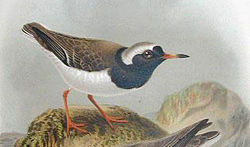Taxonomy
The genus Thinornis was introduced in 1844 by the English zoologist George Robert Gray to accommodate a single species, Thinornis rossii G.R. Gray, which is now considered a junior synonym of Charadrius novaeseelandiae J.F. Gmelin, the shore plover. [1] [2] The genus name combines the Ancient Greek this meaning "beach" or "sand" with ornis meaning "bird". [3] Genetic studies have shown that Thinornis is sister to the genus Charadrius . [4] [5]
The genus contains seven species: [6]
An additional species, the Auckland Islands shore plover (Thinornis rossii), known from just one specimen collected in 1840, is now generally considered to be a juvenile shore plover whose location was incorrectly recorded. [7]
This page is based on this
Wikipedia article Text is available under the
CC BY-SA 4.0 license; additional terms may apply.
Images, videos and audio are available under their respective licenses.










